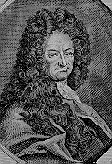
Gottfried Wilhelm,
Freiherr von Leibniz
1646-1716

Descartes' Lost Theorem

Gottfried Wilhelm, Freiherr von Leibniz 1646-1716 |
In 1675 and 1676, when Leibniz was in Paris, he had access to Descartes' papers
chez Clerselier. He made copies of many of them, and
in particular a copy of the Treatise in his own hand.
The copy remained among Leibniz' papers after his death, unrecognized
and still unpublished. Some hints by biographers and in Leibniz'
correspondence led to its discovery towards the middle of the XIX
century. (By then, the original manuscript had disappeared).
|
followed the usage of Clavius and the italian algebraists of the beginning of the seventeenth century. This story, as well as the version I have followed, is that given in the Adam-Tannery Oeuvres de Descartes, Paris 1908 (Vol. X).
Part of the interest that greeted the discovery of the Treatise was due to the equivalence between Descartes' Lost Theorem and a very famous theorem of Leonhard Euler. By Euler's time, scientific journals existed, and his theorem and its proof were published in two consecutive articles in the Communications of the St. Petersburg Academy for 1752-53.